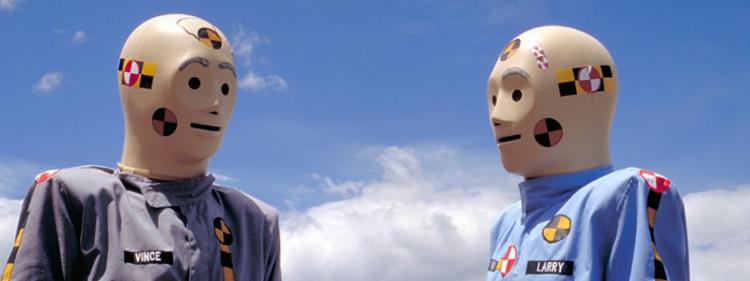Are Crash Test Dummies Really Like People?

What are crash test dummies, really? What are they made of and how long have researchers been using them to make our cars safer on the road? These high tech mannequins have a rich and somewhat sordid history.
In fact, the first crash test dummies were not mannequins at all - so how did this technology develop? We wondered, too, so we've put together a little overview of the crash test dummy and how it came to be.
Before reading on, make sure you're covered with an affordable car insurance policy.
What Are Crash Test Dummies?
A crash test dummy is an anthropomorphic testing device (ATD). This is a fancy way to say that the dummies closely imitate the size, shape, mass, stiffness and energy absorption of an actual human being. A few facts about today’s crash test dummies:
- A simple model costs about $130,000 to make
- A dummy that is fully equipped with sensors and measuring devices costs upwards of $200,000
- Auto manufacturers use crash test dummies to test car safety features such as air bags and seat belts
- These safety features are estimated to have saved 329,000 lives since 1960
Is It True That the First Crash Test Dummies Were Human Cadavers?
Believe it or not, yes. Researchers employed human bodies as crash test dummies since they most closely simulated a live human. However, ethics and public opinion prevailed over this practice. Not only that, but many questions arose over the validity of the data and whether the subjects represented the experience of a living person in a car accident.
Researchers then used themselves as the next generation of crash dummies. Lawrence Patrick, a researcher at Wayne State University, buckled himself into a rocket sled and took hundreds of rides to test how rapid deceleration affects the human body. He and his team also took blunt force blasts to the chest and face.
Patrick conceded the tests hurt. The other downside was that the researchers could only use so much force in live human testing. However, the data he and his students generated became the basis of the mathematical models that shaped future crash tests.
Once crash testing evolved to measure the survivability of auto collisions, researchers tested with live animals. Primarily, they used pigs since they could sit upright in a car and had a similar internal structure to humans. But the obvious effect on the public, and the outcry of animal rights activists, brought these practices to an end as well.
When Were Modern Crash Test Dummies Invented?
The Sierra Engineering Company invented the first crash test dummy in 1949. Sierra created “Sierra Sam” in the image of a 95th percentile adult male. The U.S. Air Force used Sam to test aircraft ejection seats using rocket sleds. Over the next 48 years, Sierra Sam evolved into the modern crash test dummy, “Hybrid III,” who is designed as a 50th percentile male.
GM developed Hybrid III in 1977 and twenty years later, he had become the industry standard for auto crash testing. Hybrid III was designed to measure frontal impact. In recent years, designers have created a whole new group of dummies to test other types of impact as well.
- SID (Side Impact Dummy): Measures side impacts, the second most common cause of severe injuries in a crash.
- BioRID: Designed to test rear impacts, primarily so automakers can enhance head and neck restraints and lower the incidence of whiplash.
- CRABI: Child dummy that is used to test child restraints, seat belts and airbags.
- THOR: The heir apparent to Hybrid III, due to an advanced spine, pelvis and face, providing better data on facial impact.
What Are Crash Test Dummies Made of?
The skeleton of a crash test dummy is constructed of aluminum and steel. Each skeleton has six ribs made of steel and synthetic plastic to mimic a human chest. Vinyl skin stretches over the skeleton. Each dummy is rigged with advanced electronic tools that measure a range of effects on the human body from acceleration, electronic force, torque and deflection. Researchers then take this data and crunch the numbers to determine how to make cars safer.
How Have Crash Test Dummies and Crash Testing Improved Car Safety?
Times have definitely changed, and the cars we drive today are like space craft compared to the early automobile. As of 1930, more than 15 people died for every 100 million miles traveled in a car. With these statistics on the rise, auto manufacturers began to take some heat, and the research that resulted in development of our friend Sierra Sam and his descendants began.
By 2011, with the major advancements in vehicle safety that crash test dummy research has generated, auto accident fatalities decreased to one person per 100 million miles traveled. Thanks to these super-sophisticated gluttons for punishment, as well as improvements in driver safety training, car drivers and passengers are 15 times less likely to experience a fatal car crash today.
Still, you should always make sure you're covered with an affordable car insurance policy.
